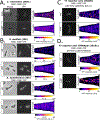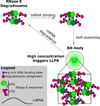α-Proteobacterial RNA Degradosomes Assemble Liquid-Liquid Phase-Separated RNP Bodies
- PMID: 30197298
- PMCID: PMC6151146
- DOI: 10.1016/j.molcel.2018.08.003
α-Proteobacterial RNA Degradosomes Assemble Liquid-Liquid Phase-Separated RNP Bodies
Abstract
Ribonucleoprotein (RNP) granules play an important role in organizing eukaryotic mRNA metabolism via liquid-liquid phase separation (LLPS) of mRNA decay factors into membrane-less organelles in the cytoplasm. Here we show that the bacterium Caulobacter crescentus Ribonuclease (RNase) E assembles RNP LLPS condensates that we term bacterial RNP-bodies (BR-bodies), similar to eukaryotic P-bodies and stress granules. RNase E requires RNA to assemble a BR-body, and disassembly requires RNA cleavage, suggesting BR-bodies provide localized sites of RNA degradation. The unstructured C-terminal domain of RNase E is both necessary and sufficient to assemble the core of the BR-body, is functionally conserved in related α-proteobacteria, and influences mRNA degradation. BR-bodies are rapidly induced under cellular stresses and provide enhanced cell growth under stress. To our knowledge, Caulobacter RNase E is the first bacterial protein identified that forms LLPS condensates, providing an effective strategy for subcellular organization in cells lacking membrane-bound compartments.
Keywords: P-bodies; RNA degradation; RNase E; bacteria; liquid-liquid phase separation; mRNA decay; stress granules.
Copyright © 2018 Elsevier Inc. All rights reserved.
Conflict of interest statement
Declaration of Interests
The authors declare no competing interests exist.
Figures







References
-
- Ait-Bara S, and Carpousis AJ (2015). RNA degradosomes in bacteria and chloroplasts: classification, distribution and evolution of RNase E homologs. Mol. Microbiol 97, 1021–1135. - PubMed
Publication types
MeSH terms
Substances
Grants and funding
LinkOut - more resources
Full Text Sources
Other Literature Sources
Research Materials

